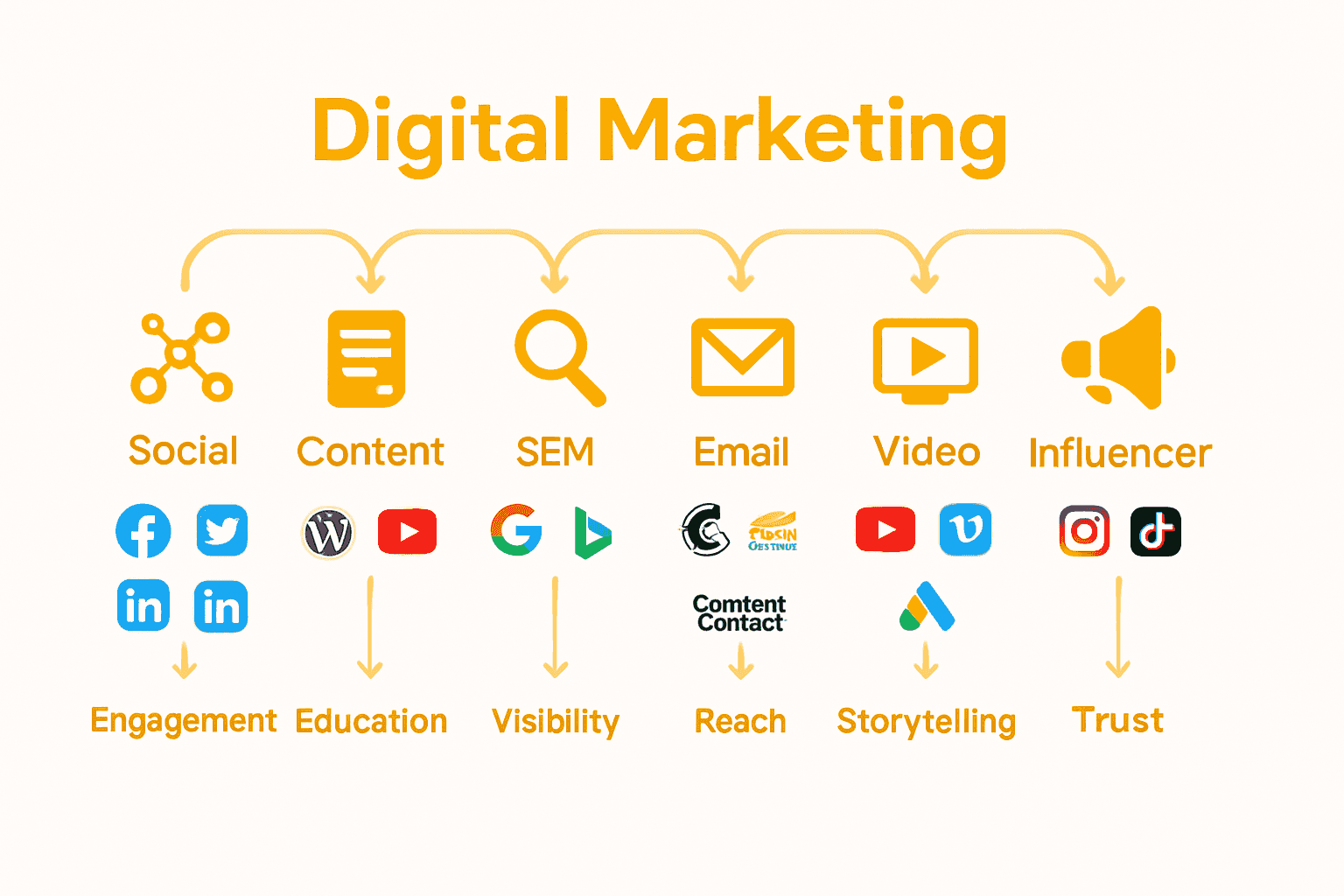Complete Guide to All Digital Marketing Channels
- Eddie The Chef

- Oct 21
- 7 min read

More than 96 percent of Australians now access the internet daily, shaping how businesses build relationships and grow sales. With so many options for connecting with customers online, selecting the right digital marketing channels can be overwhelming. Understanding the unique strengths and uses of each channel empowers businesses to reach audiences more effectively and maximise results in a crowded digital marketplace.
Key Takeaways
Point | Details |
Understanding Key Channels | Businesses should leverage multiple digital marketing channels, including SEM, social media, and content marketing, to optimize customer engagement. |
Target Local Audiences | Regional businesses should focus on hyperlocal strategies, utilizing local SEO and community-centric targeting for better customer connection. |
Data-Driven Approaches | Utilizing analytics and performance tracking can enhance digital marketing effectiveness, enabling precise targeting and real-time optimization of campaigns. |
Mitigating Risks | To avoid common pitfalls, businesses must adopt a balanced marketing strategy that considers long-term growth over quick wins and remains adaptable to market changes. |
Table of Contents
Defining Digital Marketing Channels and Concepts
Digital marketing channels represent the strategic pathways businesses use to connect with potential customers through online platforms and technologies. According to research from Understanding Digital Marketing, these channels encompass a broad spectrum of digital strategies designed to engage, attract, and convert audiences in the increasingly connected Australian marketplace.
At its core, digital marketing involves leveraging electronic technologies to communicate brand messages, with key channels including:
Search Engine Marketing (SEM): Paid advertising on search platforms
Social Media Marketing: Engagement through platforms like Facebook, Instagram, LinkedIn
Content Marketing: Creating valuable online content to attract customers
Email Marketing: Direct communication through targeted electronic messaging
Video Marketing: Storytelling and promotion through video content
Research indicates that Australian businesses are rapidly adopting these digital strategies, with high internet penetration and mobile accessibility driving significant online engagement. As digital landscapes evolve, channels like AI-powered automation and targeted analytics are becoming increasingly sophisticated, allowing businesses to create more personalised and responsive marketing experiences.
For regional businesses seeking to expand their digital presence, understanding these channels is crucial. The Ultimate Guide to Digital Marketing: Choosing the Right Strategy for Your Business provides deeper insights into selecting and implementing the most effective digital marketing approaches tailored to specific business needs.
Key Types of Digital Marketing Channels
Digital marketing encompasses a diverse range of strategic channels designed to help businesses connect with their target audiences online. According to research from Adobe Business, the core digital marketing channels in the Australian market can be categorized into several key types that offer unique opportunities for engagement and growth.
The primary digital marketing channels include:
Here’s a comparison of the main digital marketing channels and their key features in the Australian market:

Channel | Main Purpose | Typical Platforms | Key Strengths |
Social Media Marketing | Brand visibility & engagement | Facebook Instagram LinkedIn | Broad reach High user activity |
Content Marketing | Attract & inform audiences | Blogs Videos Infographics | Builds trust SEO benefits |
Search Engine Marketing | Drive website traffic | Google Search Bing | High intent traffic Measurable |
Email Marketing | Direct communication | Mailchimp Campaign Monitor | Personalisation Cost-effective |
Video Marketing | Storytelling & promotion | YouTube TikTok Facebook Video | Visual impact High engagement |
Paid Advertising | Quick visibility | Google Ads Display networks | Scalable reach Targeted spend |
Influencer Marketing | Extend brand reach | Instagram YouTube Blogs | Trust transfer Niche targeting |
Social Media Marketing: Leveraging platforms like Facebook, Instagram, LinkedIn for brand visibility
Content Marketing: Creating valuable content such as blog posts, videos, infographics, and case studies
Search Engine Marketing (SEM): Including both organic SEO and paid search advertising
Email Marketing: Direct communication and nurturing customer relationships
Video Marketing: Storytelling and promotional content across multiple platforms
Paid Advertising: Display ads, PPC, and targeted online advertising campaigns
Influencer Marketing: Collaborating with industry personalities to extend brand reach
Research from CMLabs highlights that Australian businesses are increasingly adopting a multi-channel approach, recognizing that each channel offers unique strengths in reaching and engaging potential customers. The key is to develop a strategic mix that aligns with specific business goals and target audience preferences.
For regional businesses looking to dive deeper into email marketing strategies, understanding how to effectively leverage these channels can significantly enhance online visibility and customer engagement.
Channel Features and How They Work
Digital marketing channels operate through complex mechanisms that enable businesses to precisely target and engage potential customers. According to insights from Rocket Agency, successful digital strategies involve understanding how different channels function and interact throughout the customer journey.
Key channel features and operational dynamics include:
Targeting Precision: Leveraging first-party data and CRM insights to create highly specific audience segments
Performance Tracking: Monitoring critical metrics like Cost Per Click (CPC), Cost Per Thousand Impressions (CPM), and Return on Ad Spend (ROAS)
Channel Integration: Combining organic search, paid advertising, social media, and email marketing for comprehensive coverage
Adaptive Strategies: Balancing long-term brand building with short-term performance marketing objectives
Real-Time Optimization: Continuously adjusting campaigns based on immediate performance data
Research from The SEO Spot highlights that Australian businesses are increasingly using sophisticated targeting techniques across platforms like Google Search, Shopping, Meta, and TikTok. These channels offer unique features that allow businesses to reach specific audience segments with remarkable precision.
For regional businesses looking to enhance their digital marketing approach, understanding these channel features is crucial. What is Digital Marketing? provides additional insights into how businesses can effectively leverage these dynamic digital marketing tools.
Channel Selection for Regional Businesses
Choosing the right digital marketing channels requires strategic planning tailored specifically to regional business needs. According to research from New Journey 365, successful regional businesses are increasingly adopting hyperlocal marketing strategies that leverage targeted, community-focused digital approaches.
Key considerations for channel selection include:
Local SEO Optimization: Prioritizing Google Business Profile and location-specific keywords
Mobile-Friendly Platforms: Ensuring websites and marketing content are fully responsive
Community-Centric Targeting: Using geo-targeted advertising and locally relevant content
Data-Driven Decision Making: Utilizing CRM analytics to understand local market dynamics
Omnichannel Integration: Creating seamless experiences across multiple digital touchpoints
Research from Dezign Digital emphasizes the critical importance of local digital strategies, highlighting that regional businesses must focus on channels that directly connect with their immediate community. This means prioritizing platforms that offer precise targeting and measurable local engagement.

For those looking to dive deeper into regional marketing approaches, 7 Examples of Regional Branding Strategies for Success provides additional insights into crafting compelling local digital marketing strategies that resonate with regional audiences.
Risks, Costs, and Common Mistakes
Digital marketing presents complex challenges that can significantly impact a business’s online success. According to research from Local Digital, 47% of marketers struggle with accurately measuring return on investment (ROI), while 38% find keeping up with rapidly changing platform algorithms a persistent challenge.
Common risks and mistakes in digital marketing include:
ROI Measurement Difficulties: Inconsistent tracking and attribution of marketing efforts
Algorithm Vulnerability: Overreliance on single platform strategies
Short-Term Performance Trap: Chasing quick wins instead of sustainable growth
Data Privacy Challenges: Navigating complex first-party data collection regulations
Budget Misallocation: Inefficient spending across digital channels
Research from Rocket Agency emphasizes the critical need for a balanced marketing approach. Businesses often make the mistake of expecting instant success from a single channel, neglecting the importance of a comprehensive, long-term strategic mix that adapts to changing market dynamics.
For regional businesses seeking to mitigate these risks, Marketing Australia: Complete Guide for Regional Businesses offers strategic insights into developing a more resilient and effective digital marketing approach.
Take Your Regional Business Beyond Digital Marketing Uncertainty
Are you struggling to balance all the digital marketing channels discussed in our guide and not seeing the results you expect? The challenges of measuring ROI, keeping up with fast-changing algorithms, and connecting with local customers may leave you feeling lost or stretched thin across too many tactics. This can make growing your business online feel complicated and discouraging, especially when each channel demands unique expertise and careful coordination.

Transform confusion into real results for your regional business. At Marketing Recipes Australia, our team simplifies the digital world for Australian small to medium enterprises. We use proven strategies in email marketing and regional branding to help you avoid common pitfalls and build authentic connections with your local audience. This is the moment to stop guessing and start seeing measurable growth. Visit our main site to discover your tailored marketing recipe and book a personal strategy session today.
Frequently Asked Questions
What are the main types of digital marketing channels?
Digital marketing channels include Social Media Marketing, Content Marketing, Search Engine Marketing, Email Marketing, Video Marketing, Paid Advertising, and Influencer Marketing.
How does Social Media Marketing benefit businesses?
Social Media Marketing increases brand visibility and engagement by utilizing platforms like Facebook, Instagram, and LinkedIn to reach a wide audience and interact with customers effectively.
What are the advantages of using Content Marketing?
Content Marketing helps attract and inform audiences by providing valuable content, which builds trust, enhances SEO benefits, and fosters customer loyalty over time.
Why is choosing the right digital marketing channel important for businesses?
Selecting the right digital marketing channel is crucial because it enables businesses to connect effectively with their target audience, align their strategies with specific business goals, and maximize engagement and conversions.
Recommended
Comments